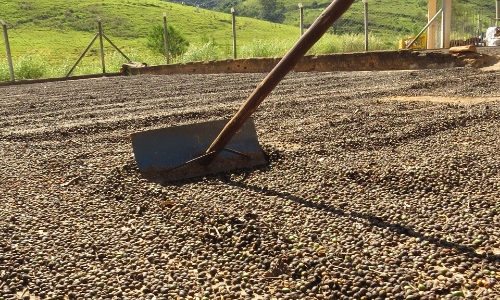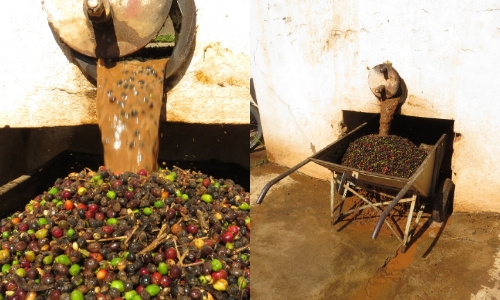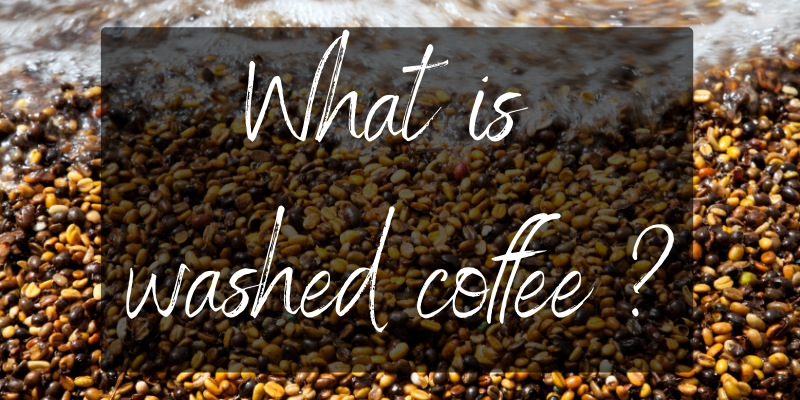Being aware of what's in a cup of coffee is a big step to a better experience. Coffee is more than a dark liquid. This well-known beverage is more than roasted dark beans and classic methods. It is a journey indeed and a delightful experience if it's done properly.
Coffee grows in all of the planet's sub-tropical zones. And each country has its own way of cultivating, harvesting and processing the beans. All of this will determine the final taste, and your experience.
In some countries after the coffee is harvested, coffee beans are processed via 'wet process'. This will produce what we know as washed coffee.
So let's jump in and see what is washed coffee, and why this processing method produces these results.
Table of Contents
What is washed coffee?
A coffee cherry is a complex fruit. From the fruit itself to green beans, it's a lengthy process. And this process can be distinctive depending on the country or farmer. But have you ever wondered what is inside of a coffee cherry?
From the exterior to interior, in the fruit there are some layers: pulp → mucilage → parchment → silver skin → two green beans.
To separate these two beans from those layers, there are two main methods: wet and dry. And from these two are derived other methods like semi-washed or pulped natural.
The wet process gives us washed coffee. You may have seen this label on some coffee packs, especially the 3rd wave coffee that actually states info about the production methods.
Washing coffee the main technique used in coffee farms to convert the coffee cherries into green beans ready for roasting.
Washed coffee process step-by-step
Sorting
After the cherries are picked from the plant, it is essential to sort them for unripe, defects, twigs, or anything that can affect the process. This step can be done manually or using machines.
In the first place, the collected coffee cherries are placed in large tanks of water and separated from any unripe or rotten fruits, dry materials or foreign bodies, by the force of gravity.
Pulping
After the first step, the cherries are spread through a pulping machine to separate the flesh and skins. This machine is called a depulper.
Then the beans are divided by weight as they pass through water channels. The lighter beans float to the top, while the heavier ripe beans sink to the bottom.
Fermentation

The next step is controlled fermentation in tanks full of water.
For the next 12 to 36 hours, micro-organisms carry out the fermentation process to facilitate the elimination of mucilage.
The duration of the process depends on the temperature and must be monitored.
You know this step has been done properly when the surface of the beans is no longer mucous-like.
However, if the beans are in the water too long, they can be over-fermented, causing "fluorescent beans". One single stinker bean can ruin an entire batch of coffee.
The process is complete when the parchment skin is no longer moist, then coffee beans are dried in the clean parchment skin.
Drying
In the final phase, the parchment is carefully washed and dried in the sun, and turned regularly to prevent the formation of mold.
In every processing method, the coffee needs to be dried until it has a moisture content of 10-12% before packaging to secure problem-free transportation.
Packaging
Before the coffee beans are packed, they have to pass through decortication, cleaning, sorting, and quality check. Once classified, the "green gold" is packaged in burlap bags weighing 60-69 kg.
Why is coffee washed?
There can be several reasons for picking this processing method over another.
For example, in Guatemala, dry processing is usually not accepted. That is because the country's moist weather would ferment the coffee, making it go bad.
For this purpose in Guatemala only coffee of more inferior quality is dried without being pulped.
So, the weather in the area can determine the processing method.
Besides weather, which is the main factor for using this process, taste is another reason for picking washed coffee. Along the years, a lot of farmers and roasteries think that washed coffee has a better taste due to the complex process.

What does washed coffee taste like?
Washed coffee has a very high acidity due to time spent in the fermentation tanks. This is usually perceived as citric acidity.
Also, the fermentation time brings the coffee in the "fruit aroma zone" with less sweetness and less body.
Is washed coffee better?
There was a time when washed coffee had the title of better coffee, because it's more expensive than the natural process, and demands a lot of work.
Also, there was an idea that washed coffee is cleaner than natural coffee because it spends some time in the water.
However, every process has good parts and bad parts parts. On one hand, washed coffee has a high acidity, less body, and less sweetness, and this can be a better coffee for those who like their coffee in this way.
On the other hand, washed coffee is very hard to control when brewing. It requires a lot of experience to manage the extractions and to appreciate the taste. For some people, this kind of process can be perceived as sour and watery coffee.
What about natural coffee?
Before we make some comparisons between these two processing methods, let's have a short look at what natural coffee is.
This one is the oldest of all coffee processing methods. In this, the fruits are placed out in thin layers to dry in direct sunlight.
They are spread on special trestles and left for a couple of weeks until the moisture content in the drupe drops to around 12%. Hulling machines complete the last step, separating the green bean from the now dry fruit.
This process is more suitable for a warm and dry climate, and it is the most affordable method used where water is quite expensive or out of the way.

Washed vs natural coffee
Although there are many other processing methods derived from wet or dry methods as pulped natural or semi-washed, a lot of farmers still practice the traditional methods.
In the first place, washed coffee is a more expensive method than natural coffee. It requires approximately 130-150 liters of water per kilogram (2,2 lbs) of raw coffee. For countries where water is inaccessible, this method can not be applied.
On the other hand, natural processed coffee is cheaper and develops a sweeter taste, and more body with the least amount of acidity, while washed coffee is on the opposite side.
Another difference between them is the consistency. Washed coffee tends to be more challenging to work with than natural coffee.
It is more unstable as a coffee and requires some constant changes for extracting a constant coffee. On the other side, natural coffee is quite easy to adjust for better extractions.
This is why it is better for home users to experience the difference between these two processes.
If you want to know more about coffee or tea, feel free to check the related articles below. Who knows what else you might find ?





